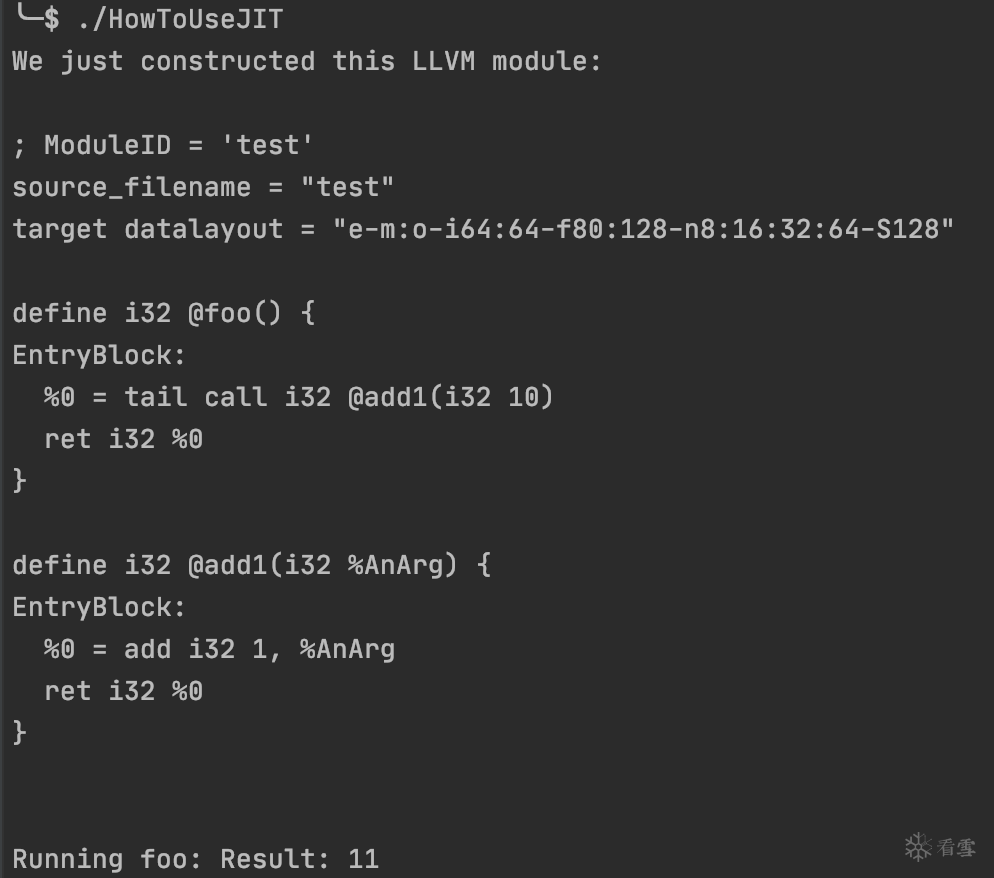初探LLVM JIT: 一个最小的JIT的例子(llvm 8)
我接触llvm的主要目的是写pass,但llvm ir以及ir对应的api让我很头疼。为了快速熟悉这套api,我需要一种快速编写、快速测试的方法,最后了解到llvm jit的存在。
但是在网上找了一些教材后,发现都不能顺利的跑起来,就连llvm源码中提供的example我也没能顺利的跑起来,一度让我怀疑自己是不是该放弃。在垂死挣扎之后,终于让我跑通了。
下面用一个简单例子来演示怎么使用llvm api新建module以及function,并且用jit去执行函数。
我们的目的是生成下面两个函数,并且调用foo,最后能打出执行结果11。 1
2
3
4
5
6
7
| int add1(int x) {
return x+1;
}
int foo() {
return add1(10);
}
|
我把整个代码分成两部分,一部分是使用llvm ir指令生成上面函数,第二部分是使用llvm jit去执行上面函数。
下面是第一部分代码, 1
2
3
4
5
6
7
8
9
10
11
12
13
14
15
16
17
18
19
20
21
22
23
24
25
26
27
28
29
30
31
32
33
34
35
36
37
38
39
40
41
42
43
44
45
46
47
48
49
50
51
52
53
| int initModule(LLVMContext &Context, Module *M, Function *FooF) {
// Create the add1 function entry and insert this entry into module M. The
// function will have a return type of "int" and take an argument of "int".
Function *Add1F =
cast(M->getOrInsertFunction("add1", Type::getInt32Ty(Context),
Type::getInt32Ty(Context)));
// Add a basic block to the function. As before, it automatically inserts
// because of the last argument.
BasicBlock *BB = BasicBlock::Create(Context, "EntryBlock", Add1F);
// Create a basic block builder with default parameters. The builder will
// automatically append instructions to the basic block `BB'.
IRBuilder<> builder(BB);
// Get pointers to the constant `1'.
Value *One = builder.getInt32(1);
// Get pointers to the integer argument of the add1 function...
assert(Add1F->arg_begin() != Add1F->arg_end()); // Make sure there's an arg
Argument *ArgX = &*Add1F->arg_begin(); // Get the arg
ArgX->setName("AnArg"); // Give it a nice symbolic name for fun.
// Create the add instruction, inserting it into the end of BB.
Value *Add = builder.CreateAdd(One, ArgX);
// Create the return instruction and add it to the basic block
builder.CreateRet(Add);
// Now, function add1 is ready.
// Now we're going to create function `foo', which returns an int and takes no
// arguments.
// Add a basic block to the FooF function.
BB = BasicBlock::Create(Context, "EntryBlock", FooF);
// Tell the basic block builder to attach itself to the new basic block
builder.SetInsertPoint(BB);
// Get pointer to the constant `10'.
Value *Ten = builder.getInt32(10);
// Pass Ten to the call to Add1F
CallInst *Add1CallRes = builder.CreateCall(Add1F, Ten);
Add1CallRes->setTailCall(true);
// Create the return instruction and add it to the basic block.
builder.CreateRet(Add1CallRes);
}
|
下面是第二部分代码 1
2
3
4
5
6
7
8
9
10
11
12
13
14
15
16
17
18
19
20
21
22
23
24
25
26
27
28
29
30
31
32
| int main() {
LLVMInitializeNativeAsmPrinter();
InitializeNativeTarget();
LLVMContext Context;
// Create some module to put our function into it.
std::unique_ptr Owner = make_unique("test", Context);
Module *M = Owner.get();
Function *FooF =
cast(M->getOrInsertFunction("foo", Type::getInt32Ty(Context)));
initModule(Context, M, FooF);
// Now we create the JIT.
ExecutionEngine *EE = EngineBuilder(std::move(Owner)).create();
outs() << "We just constructed this LLVM module:" << *M;
outs() << "Running foo: ";
outs().flush();
// Call the `foo' function with no arguments:
std::vector noargs;
GenericValue gv = EE->runFunction(FooF, noargs);
// Import result of execution:
outs() << "Result: " << gv.IntVal << "";
delete EE;
llvm_shutdown();
return 0;
}
|
最后使用clang++进行编译生成可执行文件 1
| clang++ -g HowToUseJIT.cpp `llvm-config --cxxflags --ldflags --system-libs --libs core mcjit native orcjit` -rdynamic -O3 -o HowToUseJIT
|
下面是执行的效果,可以看到生成的中间代码以及运行的结果。通过这种方式,感觉可以很方便的学习llvm ir指令以及对应的api。
初探LLVM JIT: 一个最小的JIT的例子(llvm 8)

代码仓库地址
|  |免责声明|小黑屋|依星资源网
( 鲁ICP备2021043233号-3 )|网站地图
|免责声明|小黑屋|依星资源网
( 鲁ICP备2021043233号-3 )|网站地图